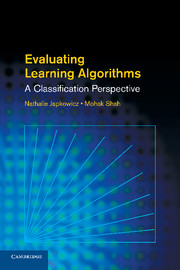Book contents
- Frontmatter
- Contents
- Preface
- Acronyms
- 1 Introduction
- 2 Machine Learning and Statistics Overview
- 3 Performance Measures I
- 4 Performance Measures II
- 5 Error Estimation
- 6 Statistical Significance Testing
- 7 Datasets and Experimental Framework
- 8 Recent Developments
- 9 Conclusion
- Appendix A Statistical Tables
- Appendix B Additional Information on the Data
- Appendix C Two Case Studies
- Bibliography
- Index
Appendix C - Two Case Studies
Published online by Cambridge University Press: 05 August 2011
- Frontmatter
- Contents
- Preface
- Acronyms
- 1 Introduction
- 2 Machine Learning and Statistics Overview
- 3 Performance Measures I
- 4 Performance Measures II
- 5 Error Estimation
- 6 Statistical Significance Testing
- 7 Datasets and Experimental Framework
- 8 Recent Developments
- 9 Conclusion
- Appendix A Statistical Tables
- Appendix B Additional Information on the Data
- Appendix C Two Case Studies
- Bibliography
- Index
Summary
This appendix is a companion to Chapter 9. In particular, it discusses two case studies that illustrate the evaluation framework laid out in that chapter and whose details were discussed all throughout the book. The first case study focuses on a practical (albeit semiartificial) domain; the second uses datasets from the UCI Repository for Machine Learning. The two studies are now discussed in turn.
Illustrative Case Study 1
In this case study, we used the dataset generated by Health Canada for the 2008 ICDM Data Contest. The purpose of the data is to serve as a basis for construction of automated learning systems able to monitor the amount of a few particular xenon isotopes (radioxenon) released in the atmosphere in an effort to verify compliance of the global ban on nuclear tests (the Comprehensive Nuclear Test Ban Treaty or (CTBT). These isotopes, when released in some given pattern, are characteristic of nuclear explosions. What makes the problem difficult, however, is that the monitoring stations are typically not located at the site of the explosion. Instead, the isotopes are transported, over days or weeks, through various weather systems, toward these stations and, in the process, lose their characteristic pattern. This is further complicated by the fact that xenon isotopes in various quantities are present in the atmosphere at the sites of the monitoring stations. This is due to the release of such gases by perfectly legal civil nuclear plants such as medical isotope production facilities and nuclear power plants.
- Type
- Chapter
- Information
- Evaluating Learning AlgorithmsA Classification Perspective, pp. 368 - 392Publisher: Cambridge University PressPrint publication year: 2011

